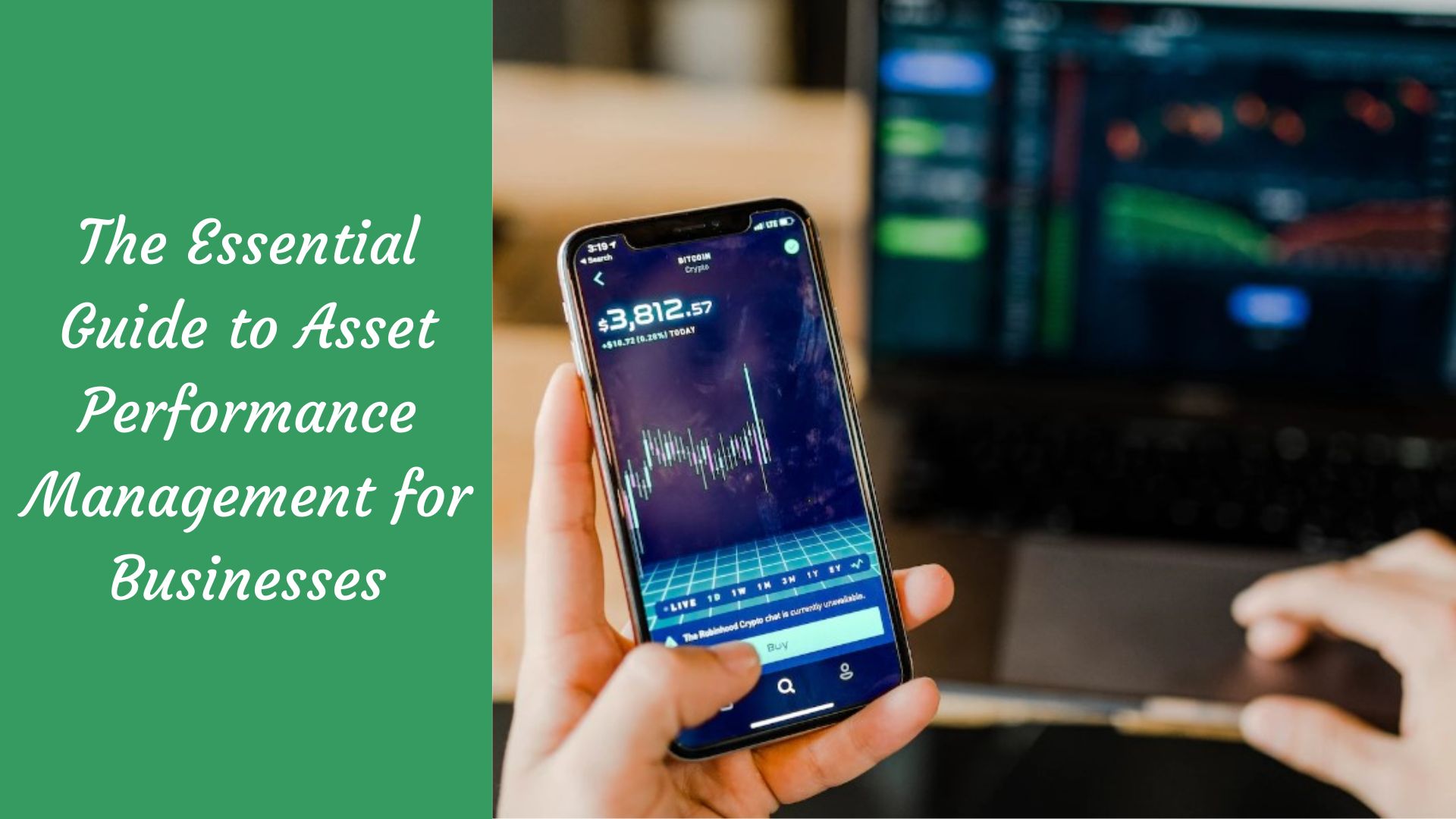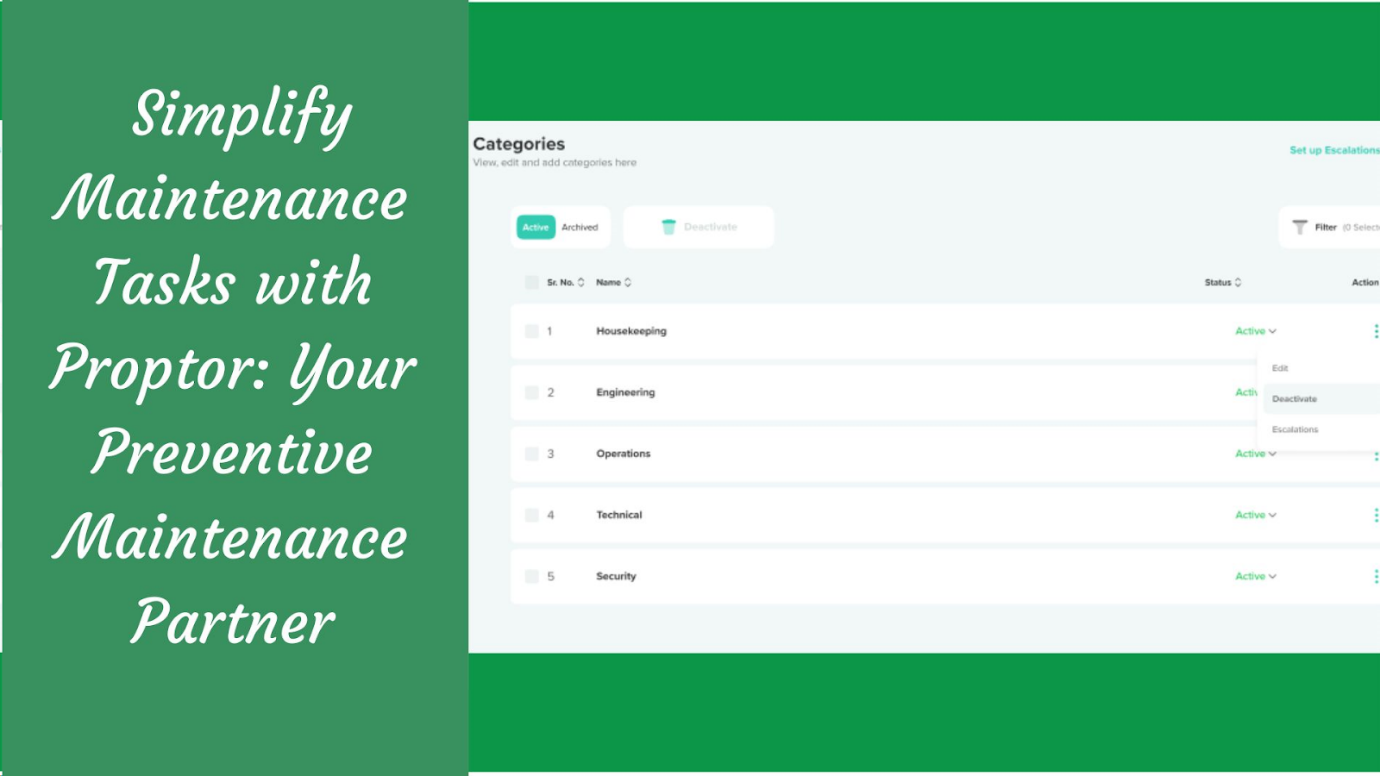
The Essential Guide to Asset Performance Management for Businesses
Kirti Prakash |
10 May 2024 |
16:33 PM
- What is Asset Performance Management?
- Components of Asset Performance Management
- Process in Asset Performance Management
- Benefits of using Asset Performance Management
- What is Asset Performance Management Software ?
- Proptorapp: Your Asset Performance Management Solution
- Conclusion

Simplify Maintenance Tasks with Proptor: Your Preventive Maintenance Partner
Shubham Vakharia 05 Jun 2024 | 10:00 AMDiscover how Proptor App streamlines preventive maintenance for property owners and managers, making it easier to schedule tasks, track costs, and ensure timely upkeep for your properties. Get started today! ...
If you've ever wondered how to make your assets work smarter and align them with your business goals, you're in the right place.
This article is all about Asset Performance Management—what it is, why it matters, and how it can benefit your business.
We'll explore the core components of APM, from its focus on business goals to navigating the asset ecosystem, leveraging digital tools, harnessing data and analysis, and redefining best practices.
What is Asset Performance Management?
Asset Performance Management (APM) isn't just about maintaining your physical assets; it's a dynamic approach that aligns your asset management with your broader business objectives. It's a strategic approach that has redefined the way organizations manage their assets.
In an era marked by digital transformation and evolving business landscapes, APM has emerged as a vital tool that bridges the gap between traditional asset management practices and cutting-edge digital technologies.
Components of Asset Performance Management
In this section, we'll read into the core components of APM and how it can revolutionize your business operations.
1. Understanding Business Goals in APM
At the heart of APM lies a crucial shift—placing business goals at the forefront. It's not merely about keeping machines running; it's about achieving higher revenue, profitability, and customer satisfaction.
Imagine the power of a strategy that not only ensures your assets perform optimally but also enhances your bottom line. APM does precisely that by aligning every asset-related decision with your overarching business objectives.
2. Navigating the Asset Ecosystem
The APM landscape extends far beyond the plant floor. It encompasses a diverse ecosystem that includes a multitude of applications across asset-intensive industries.
This ecosystem involves a sophisticated interplay of Operational Technology (OT), Information Technology (IT), and engineering systems.
From production and maintenance to engineering personnel, third-party partners, and service providers—APM weaves them all together. It's a holistic approach that transcends traditional asset management boundaries.
3. Leveraging Digital Tools for APM
In the age of digital transformation, APM harnesses the power of cutting-edge technologies. Picture a world where smart devices, augmented reality, and mobility aren't just buzzwords but integral tools for optimizing your asset management processes.
Modern APM integrates these digital tools seamlessly, revolutionizing the way you monitor, maintain, and manage your assets.
4. Harnessing Data & Analysis for APM
Data is the lifeblood of APM. It's not just about collecting information; it's about extracting actionable insights that drive your business forward.
APM embraces digital twins, digital threads, and modern information assimilation techniques. It enables deeper collaboration across your asset ecosystem, providing you with the information you need when you need it.
5. Best Practices and Applications in APM
Traditional asset management practices become even more potent when enhanced by data, digital tools, and a laser focus on business goals.
APM redefines best practices, taking them to new heights. It's not a one-size-fits-all solution but a tailored approach that adapts to your unique needs and aspirations.
Process in Asset Performance Management
In the process of Asset Performance Management (APM), success is achieved through a series of well-defined steps.
Let's take a guided tour through these sequential stages of APM, each designed to bring your assets in sync with your business objectives.
1. Setting the Foundation for APM
Before diving into the intricacies of APM, it's essential to establish a strong foundation. Begin with a top-down approach that monitors assets and collects valuable data for asset utilization.
This data forms the bedrock upon which the rest of your APM strategy will be built. Think of it as laying the groundwork for a robust asset management system.
2. Data Collection and Analysis
With your foundation in place, it's time to roll up your sleeves and dive into the data.
Utilize maintenance software, such as Asset Performance Management (APM) software, Computerized Maintenance Management System (CMMS), or Enterprise Asset Management (EAM) software, to understand and analyze the information you've collected.
This step is all about transforming raw data into actionable insights.
3. Implementation and Monitoring
Data analysis isn't an end in itself; it's a means to an end. Armed with the insights gleaned in the previous step, develop a comprehensive plan to optimize your assets' maintenance schedules and your employees' work schedules.
The objective here is clear—increasing productivity at your facility. Implementation is key, but it doesn't stop there, you also need maintenance strategies.
Continuously monitor and adjust asset usage and working conditions at your facility. Simultaneously, keep a vigilant eye on asset data for trends.
As you track and analyze this data, you'll be in a position to implement new processes that drive ongoing improvement. This step transforms APM from a static strategy into a dynamic, ever-evolving force for enhancing your facility's efficiency.
4. Continuous Improvement in APM
Asset Performance Management isn't a one-and-done endeavor. It's a commitment to perpetual enhancement. As you navigate the steps of APM, remember that optimization is a journey, basically an asset lifecycle.
Embrace change, refine your processes, and adapt to emerging technologies. By doing so, you'll ensure that APM continues to be a driving force in achieving your business goals.
Benefits of using Asset Performance Management
Asset Performance Management (APM) is a strategic approach that offers several compelling benefits to organizations. In this section, we'll delve into the advantages of implementing APM in your operations
1. Reducing the Cost of Ownership with APM
With APM, you can proactively identify maintenance needs and address them before they escalate into costly repairs. By analyzing asset data and performance metrics, you gain insights into when and how to perform maintenance, ensuring that it's done at the right time and in the most cost-effective manner.
As a result, your organization can cut down on unplanned downtime and emergency repairs, which are often more expensive and disruptive.
By adopting a predictive maintenance approach, you can extend the lifespan of your assets, reduce the need for replacements, and ultimately lower your overall ownership costs.
2. Increasing Asset Availability
Through continuous monitoring and data analysis, APM identifies potential issues and risks that could impact asset performance. By addressing these concerns proactively, you minimize the chances of unexpected downtime due to equipment failure or maintenance problems.
By optimizing maintenance schedules and asset usage, you can ensure that your assets are available when needed, thus improving operational efficiency.
3. Improving Asset Reliability
Rather than managing assets individually or within specific departments, APM aligns resources and strategies across your organization to optimize asset performance.
For instance, in the event of equipment failure, spare assets can be mobilized from one facility to another, minimizing disruptions and improving reliability.
By reducing the risk of individual equipment failures and system breakdowns, APM enhances the overall reliability of your operations.
4. Minimizing Downtime through APM
APM software collects and analyzes data on asset usage over time. It forecasts and predicts potential asset failures, as well as maintenance or repair needs. Armed with this information, organizations can make data-driven decisions regarding resource allocation and asset utilization.
By utilizing APM's predictive capabilities, you can optimize resource allocation, deploy maintenance teams efficiently, and avoid costly downtime. APM provides you a reliability centered maintenance, ensuring that they continue to operate smoothly even in the face of potential challenges.
What is Asset Performance Management Software ?
Asset Performance Management Software, often abbreviated as APM software, is a technological powerhouse designed to streamline asset management and optimize performance.
It's the digital tool that aligns your assets with your business objectives, paving the way for improved reliability, reduced downtime, and cost-effective operations.
APM software allows you to monitor asset health, track performance, and predict maintenance needs with precision. It's like having a crystal ball that foretells potential issues, helping you take proactive measures before they become costly problems.
Proptorapp: Your Asset Performance Management Solution
Proptorapp isn't just your average inventory management software; it's a comprehensive asset performance management solution designed to empower businesses with the tools they need to optimize asset performance, reduce costs, and enhance operational efficiency.
1. Real-time Inventory Tracking
With Proptorapp, you can track not only your physical inventory but also your critical assets. Real-time updates on stock levels ensure you have full visibility into your assets' availability and consumption rates.
2. Automated Alerts and Notifications
Never worry about running out of critical supplies or experiencing unexpected downtime. Proptorapp's automated alerts keep you informed about any potential issues, allowing you to take proactive measures to prevent disruptions.
3. Consumption Monitoring
Proptorapp goes beyond inventory management; it helps you monitor electricity, water, fuel, and other asset consumptions. This data empowers you to make informed decisions, track expenses, and optimize resource allocation.
4. Predictive Analytics
Leveraging millions of historical records, Proptorapp provides predictive analytics that offer valuable insights into your assets, people, and company data. Anticipate maintenance needs, optimize resource allocation, and make data-driven decisions.
5. Automation of Inspection and Audits
Say goodbye to cumbersome paperwork and manual data collection. Proptorapp automates the inspection and audit processes, ensuring standardized data collection and easy report generation. This reduces errors and inconsistencies in your asset management procedures.
6. Training and Performance Tracking
Maximize employee performance while minimizing training costs. Proptorapp's cloud-based technology allows you to deliver content in various formats and track employees' progress, ensuring they are equipped to manage assets effectively.
Conclusion
In conclusion, Proptorapp is among the best traditional asset performance management solutions. It empowers you to not only manage your assets effectively but also enhance their performance, reduce operational and maintenance costs, and achieve operational excellence.
By choosing Proptorapp for your asset performance management needs, you're investing in a solution that will drive efficiency, reliability, asset health, and profitability across your organization.
Make the smart choice today—choose Proptorapp for asset performance management and unlock the full potential of your assets.